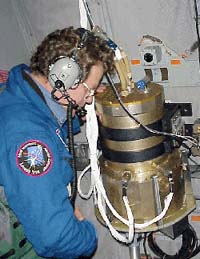|
Leonid MAC |
| home |
| View the shower |
| Mission Brief |
| Science Update |
| Media Brief |
| links |
 Ray W. Russell,
Ray W. Russell, Aerospace Corporation 
Last updated: October 2002
Brief Biographical Information: After graduate work at the University of California, San Diego, he conducted a three-year post-doc at Cornell University (flying more than 5 instruments on the KAO and LearJet) and has worked at the Aerospace Corporation since 1981, advancing to Sr. Scientist in 1997. He has served on numerous government and NASA advisory and working groups, including one for SOFIA and one for WIRE. Research: Dr. Ray Russell has conducted numerous infrared spectroscopic studies spanning the 1-210 micron region of the spectrum, as a principal investigator and collaborator. His hardware experience spans the 4-8 micron circular variable filter wheel spectrometer he developed for use on the Kuiper Airborne Observatory (KAO) in 1975 to discover the 6.2 and 7.7 micron unidentified IR emission bands and the 6.0 and 6.8 micron absorption bands, to the stressed Ge:Ga photoconductive detectors for the grating spectrometer he used on the Lear Jet to discover the [C II] line at 157 microns. His studies have included thermal IR (3-13 micron) studies of comets, asteroids, Saturn's rings, planetary nebulae, H II regions, and Herbig Ae/Be shell stars to characterize celestial dust in its many environments and with varying composition, size distributions, and crystallinity. He has developed a spectral synthesis model for reproducing cometary spectra utilizing laboratory cosmic dust analogue emissivities he has measured. Research on Leonid MAC: 2.5-13 micron Mid-IR spectroscopy of meteors. During the 1998 Leonid MAC, the BASS spectrometer was operated from the FISTA aircraft. At that time, the instrument was set up to observe the thermal emission of persistent trains. In the 1999 campaign, the instrument was used to study the thermal emission of the meteors themselves. Unfortunately, all bright meteors passed the field of view barely. In the upcoming campaign, the instrument will be aimed higher in the sky in order to benefit from slightly longer trajectories and increasing a chance of detection. |

